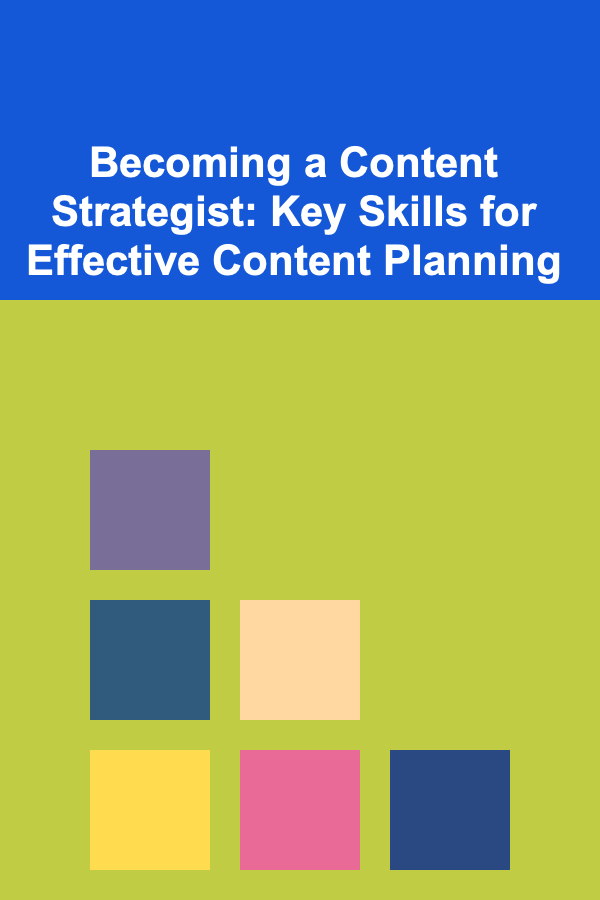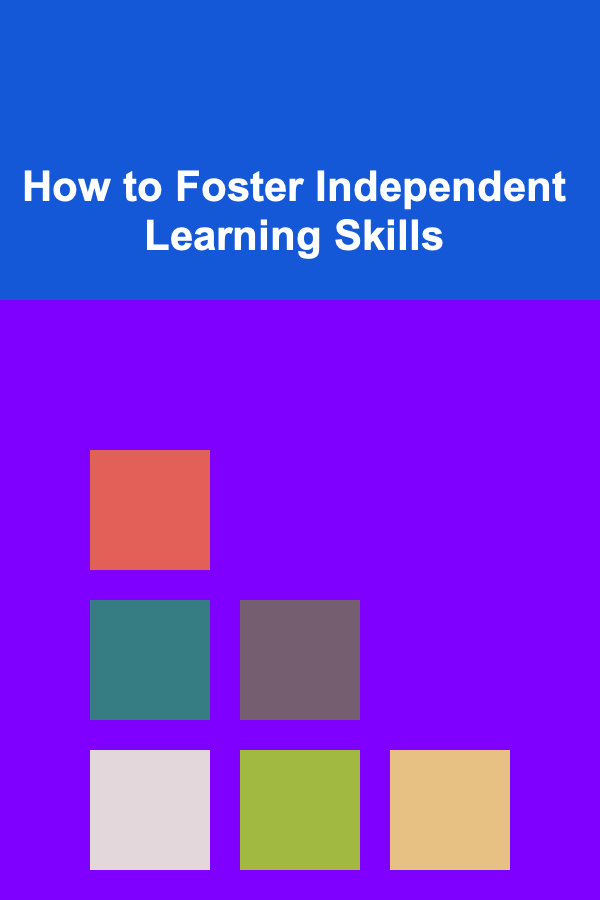
Becoming a Content Strategist: Key Skills for Effective Content Planning
ebook include PDF & Audio bundle (Micro Guide)
$12.99$5.99
Limited Time Offer! Order within the next:

The role of a content strategist has become increasingly pivotal in today's digital landscape. As businesses continue to shift towards online platforms, the demand for strategic, engaging, and valuable content is at an all-time high. A content strategist is the mastermind behind this content, ensuring it is not only creative but also aligned with the company's goals, audience preferences, and brand voice.
But what does it take to become a successful content strategist? What skills are necessary to excel in this field? This actionable guide will explore the essential skills and strategies that can help you navigate the journey to becoming an effective content strategist, from understanding your audience to measuring the impact of your content.
Understanding the Role of a Content Strategist
A content strategist is more than just a writer or editor. This role involves planning, developing, and managing content that aligns with a company's goals, values, and target audience. A content strategist must also ensure that content is consistent across all channels, optimized for search engines, and tailored to drive engagement.
Key Responsibilities:
- Content Planning: Developing content calendars and strategies that align with the business's marketing and communications objectives.
- Content Creation & Curation: Overseeing the production of high-quality content, including blog posts, social media updates, videos, and more.
- Audience Research: Understanding the needs, challenges, and behaviors of the target audience to craft relevant and engaging content.
- Analytics & Reporting: Measuring content performance through metrics like traffic, engagement, and conversions, and adjusting strategies accordingly.
- Collaboration: Working with other teams such as marketing, sales, and design to ensure content aligns with broader company goals.
Understanding the Audience
One of the foundational skills of a content strategist is the ability to understand the audience. Without a deep understanding of who you're creating content for, it's impossible to produce materials that resonate, engage, or convert.
Developing Buyer Personas:
- Conduct Audience Research: Use surveys, social media insights, and web analytics to gather data about your audience's demographics, preferences, and behaviors.
- Create Buyer Personas: Develop detailed profiles of your target audience segments. These should include information such as age, occupation, interests, pain points, and preferred channels of communication.
Segmentation and Personalization:
- Segment Your Audience: Break down your audience into sub-groups based on factors like behavior, needs, and purchasing habits. This allows you to tailor content more effectively.
- Personalize Content: Customize content to address the specific needs and preferences of different audience segments. For example, a tech company may create content specifically for developers, project managers, and CEOs, each with a different approach and tone.
Strong Writing and Communication Skills
Content strategists are, at their core, communicators. Strong writing skills are essential for articulating the brand's message clearly and persuasively. But it's not just about writing; it's about writing in a way that speaks directly to your audience.
Crafting Compelling Headlines:
- Attention-Grabbing Headlines: The first step in engaging your audience is capturing their attention. Craft compelling headlines that spark curiosity or solve a problem your audience cares about.
- Clear and Concise Language: Avoid jargon or overly complex language. Effective communication is about conveying the message in the simplest form while still maintaining clarity.
Storytelling:
- Create Stories, Not Just Content: Content that tells a story is often more engaging and memorable than purely informational content. Weave your messaging into narratives that connect with your audience emotionally.
- Brand Voice Consistency: The tone, style, and personality of your content should align with your brand's voice. Whether it's casual, formal, humorous, or authoritative, consistency is key.
SEO Knowledge and Content Optimization
A successful content strategist must have a solid understanding of Search Engine Optimization (SEO). Even the best-written content is ineffective if it doesn't reach the right audience. SEO ensures that content is discoverable and ranks well on search engines, bringing organic traffic to your site.
Keyword Research:
- Identify High-Value Keywords: Use tools like Google Keyword Planner, Ahrefs, or SEMrush to identify keywords relevant to your audience and industry. Aim for keywords that balance search volume with competition.
- Incorporate Keywords Strategically: Ensure your keywords are naturally integrated into your content, including titles, meta descriptions, and headers, without overstuffing or sacrificing readability.
On-Page SEO:
- Optimize Content for Readability: Use short paragraphs, subheadings, and bullet points to make your content scannable. Search engines like Google also reward content that is user-friendly.
- Optimize for Featured Snippets: Structure your content to target featured snippets---those concise answers displayed at the top of search results. Answering common questions directly in your content increases the likelihood of being featured.
Analytical Thinking and Data Interpretation
Content strategy is not just about creativity; it's also about measuring results and continuously improving. Understanding how to track content performance and adjust your strategy based on data is crucial.
Understanding Metrics:
- Key Performance Indicators (KPIs): Identify the most relevant metrics to your content goals, such as page views, engagement rate, bounce rate, and conversion rates.
- Use Analytics Tools: Google Analytics, social media insights, and content management system (CMS) reports can provide detailed insights into how your content is performing.
Adjusting Content Strategy:
- Evaluate Content Performance: Regularly analyze which types of content are driving the most traffic, engagement, or conversions. Use this data to inform future content creation.
- A/B Testing: Experiment with different content formats, headlines, calls to action (CTAs), and publishing times to see which resonates best with your audience.
Social Media and Digital Marketing Integration
A content strategist must also be well-versed in how to integrate content with various social media platforms and digital marketing tactics. Social media is one of the most effective channels for distributing content and fostering engagement.
Social Media Strategy:
- Platform Selection: Not every platform is right for every type of content. Understanding which platforms your audience frequents will guide your distribution strategy.
- Content Calendar: Develop a social media content calendar that aligns with your content calendar. Consistent posting keeps your audience engaged and helps build brand recognition.
- Engagement: Actively engage with your audience on social media. Responding to comments, participating in conversations, and sharing user-generated content can significantly enhance your brand's relationship with its audience.
Paid Content Promotion:
- Paid Social Media Ads: Platforms like Facebook, Instagram, and LinkedIn offer targeted advertising opportunities that can amplify the reach of your content. A content strategist should know when and how to use paid promotions to expand the content's reach.
- Retargeting: Retargeting ads allow you to show content to people who have already interacted with your website or social media. This strategy helps to keep your brand top of mind and encourages further engagement.
Project Management and Organizational Skills
Content strategists often work on multiple projects simultaneously, so the ability to stay organized and manage time effectively is essential.
Content Calendar Management:
- Plan Ahead: Develop a content calendar that outlines when and where content will be published. This ensures that you stay on track with deadlines and maintain a consistent flow of content.
- Coordination with Teams: Content strategy is often a collaborative effort. A strategist must coordinate with writers, designers, marketers, and other stakeholders to ensure content is delivered on time and aligns with broader marketing campaigns.
Flexibility and Adaptability:
- Be Prepared for Changes: The digital landscape is ever-evolving, and content strategies must adapt to new trends, changes in algorithms, or shifting business priorities. Being flexible and adaptable allows you to pivot quickly and remain relevant.
Creativity and Innovation
Content strategy is as much about creativity as it is about data and planning. Crafting innovative content that stands out in a crowded digital space requires a unique approach.
Thinking Outside the Box:
- Experiment with New Formats: Stay ahead of the curve by experimenting with different content formats---like interactive quizzes, videos, podcasts, and infographics---that resonate with your audience.
- Storytelling and Visuals: Incorporate engaging visuals, interactive elements, and well-crafted narratives into your content to make it more appealing and shareable.
Stay Informed on Trends:
- Industry Trends: A good content strategist is always aware of emerging trends in the content space. Stay up-to-date with industry news, follow thought leaders, and attend webinars or conferences to continuously hone your skills.
Collaboration and Leadership Skills
Content strategists often lead teams or collaborate with various departments, so strong leadership and interpersonal skills are crucial for success.
Cross-Functional Collaboration:
- Work with Marketing and Sales: Ensure your content strategy aligns with larger marketing campaigns and sales goals. Close collaboration with these teams will help ensure a unified approach to reaching potential customers.
- Collaborate with Designers and Developers: Your content might require support from design or development teams, especially for multimedia or interactive content. Effective communication helps you deliver cohesive and visually appealing content.
Leadership in Content Creation:
- Guiding Content Teams: A content strategist must be able to guide and inspire content creators, whether that means setting clear goals, providing constructive feedback, or managing resources efficiently.
- Mentoring: As you gain more experience, mentoring junior content creators can further enhance your skills and grow your team's capabilities.
Conclusion
Becoming a successful content strategist requires a diverse set of skills, from understanding your audience to managing projects and analyzing data. The ability to plan, create, distribute, and measure content effectively is essential for any content strategist looking to drive meaningful results. By honing these skills and continually adapting to the ever-changing digital landscape, you can position yourself as a key player in shaping a brand's content strategy and ensuring its success.

How to Maintain Your Home's Deck for Longevity
Read More
How to Organize Your Kitchen for Maximum Space Efficiency
Read More
How to Strengthen Your Front Door Against Intruders
Read More
How to Foster Independent Learning Skills
Read More
How to Landscape a Sloped Yard: A Step-by-Step To-Do List
Read More
10 Tips for Introducing a New Bird to Your Existing Flock
Read MoreOther Products

How to Maintain Your Home's Deck for Longevity
Read More
How to Organize Your Kitchen for Maximum Space Efficiency
Read More
How to Strengthen Your Front Door Against Intruders
Read More
How to Foster Independent Learning Skills
Read More
How to Landscape a Sloped Yard: A Step-by-Step To-Do List
Read More